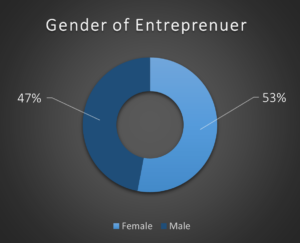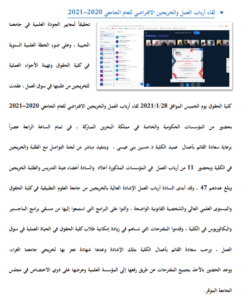Local Start-up Assistance
The Business Incubator Centre (BIC) was established officially in 29th September 2019 to support our students in developing their entrepreneurial skills and knowledge. More than 3,000 students have benefited from the Business Incubator Centre’s activities, where more than 60 activities took place. The Business Incubator Centre supervised 297 start-ups (63 startups in 2023), contributing to four economic sectors, namely, manufacturing, retailing, services, trading and agriculture. Female represent 53% of the business entrepreneurs, while 47% are male entrepreneurs in the Business Incubator Centre.

Table of ASU Graduates
https://www.asu.edu.bh/wp-content/uploads/2020/11/Student-Handbook-2020-2021.pdf
ASU have measurement / tracking of women’s likelihood of graduating compared to men’s, with the purpose of maintaining gender equity in the academic community. ASU considers itself an inclusive University and values the role of women in work activities as well as their role in the lives of others. Every year ASU performs a comparison of graduates to learn about and improve equal opportunities through new inclusion strategies.
Table 1. Numbers of women vs percentage of men 2018-2019

Table 2. Numbers of women vs percentage of men 2019-2020

The Table 1 shows the number and percentage of women graduates in 2018-2019, which shows the gender equity that ASU always maintains in its academic community, additionally in the year 2019-2020 an increase of 1% of women is seen graduated. Each year ASU develops new strategies to achieve a more inclusive community. This increase is due to the creation of new events, training in female empowerment, the creation of new policies, the socialization of the good results of ASU in different fields and the motivation generated in women by continuing their studies or starting them with ASU.
For graduation, students have a request for documentation and what processes must be taken into account in order to graduate in any of the University’s careers, with this information provided by the students, the number of women who graduate and finish their studies is tracked.
In first instance, it is worth noting that, the policies in regard to have measurement/tracking of student’s likelihood of graduating to both men and women are treated equally and protected against gender discrimination. This information is founded in the ASU Student Handbook.

Students Counselling Office
https://www.asu.edu.bh/student/student-affairs/counselling-ofice/about-the-office/
Thus, the University wishes that all of its students (males and females) make satisfactory progress toward their degree objectives and achieve academic success. However, in certain situations students might not be able to cope with the academic requirements of their program. If a situation arises where a student has special circumstances that make it impossible to complete a normal course load, the student must meet with their Academic Advisor to discuss the circumstances. In this sense:
- The university will identify students who are at risk of not being able to meet their academic commitments.
- The university will support all students in achieving their full academic potential at the university.
- The university will ensure that students who are at potential risk are identified early and informed about the help and support available to them.
- The university will assist students, who fall below the minimum academic requirements at the university, through counselling and academic advisors.

Special Need Support
https://www.asu.edu.bh/student/student-affairs/counselling-ofice/special-needs-support/
The objectives and services provided as from Student Counselling Office are:
Objectives:
- Help solve educational, social and psychological issues that students may be exposed to during their academic study in the university. As well as, pave the way for them to continue their academic career in a smooth manner.
- Organise programs to prevent and minimise the problems that may be the cause for students to fail or withdraw from the university.
- Help students understand the university’s environment, nature of the specialisation, study system and the rules and regulations specific to the students of the university.
- Develop positive values and attitude within students and motivate them to strive for excellence in their academic achievement.
- Coordinate with faculty members to address some of the educational, behavioural, social, psychological and health-related situations that may be experienced by some of the students.
- Conduct studies and research surveys to learn about the prevalence of some of the problems between the students and provide stakeholders the necessary recommendations to reduce these problems in the future.
- Organize some awareness and educational activities for students, academic and administrative staff of the university in order to develop their personal abilities and build their attitudes positively towards social counselling services.
Services provided to the students:
- Educational Counselling: It aims to follow up the students’ academic progress and address the problems that hinder their academic achievement.
- Social Counselling: It aims at building positive social attitudes among the students and to address some special cases.
- Psychological Counselling: It aims to provide assistance and necessary psychological advice to those students who need it.
- Preventive Counselling: It aims to educate students and prevent them from falling into problems; whether they were health-related, psychological or social, to maintain the positive features of their personality.
- Group Counselling: It is for those students who have similar interest, goals and issues; where those students get to learn how to gain self-confidence, communication skills, social interaction skills, group participation, and handling responsibility.
- Variety of information sources: Such as booklets, brochures, audio-visual materials relating to social counselling and enabling students to make use of them in order to help them better adapt with themselves and with others in various aspects of life.
- For students with special needs, in accordance with Bahrain laws regarding persons with special needs and academic policies at Applied Science University. The university include physical disability temporary injuries, learning disabilities, attention deficit. The university is committed to maintaining strict confidentiality with respect to the records of students with special needs.
Our services:
- Wheelchair
- Offer counselling services.
- Work cooperatively with students and instructors to provide appropriate support.
ASU for graduate students continues to offer guidance and activities by virtue of benefiting them, mentoring, guidance and activities that will enhance their professional environment and skills. Some of these activities carried out by ASU are shown below:
Alumni Club Organized Workshops
https://www.asu.edu.bh/category/news/page/23
The Alumni Club organized on Saturday, 7 May 2016, a workshop that aimed to improve the graduates’ skills on report writing and emailing practices. The inspiring workshop was delivered by Mr. Yasser Abuseneh, the Director of ASU’s Training Centre. Another workshop on “Self- Management, and motivation “was also delivered by Dr. Fatima Mohammed Al Malki, Assistant Professor at the University of Bahrain. Both workshops were attended by a large audience, chaired by Professor Ghassan Aouad, the President of Applied Science University and supervised by Ms. Noora Musalam, the Director of Career Development & Alumni Affairs Office.

Training and Education Pre-Employment Expo 2018
https://www.asu.edu.bh/category/news/page/11
The President presented on Thursday 10 May, at the first entrepreneurship panel discussion which was held on the side-lines of the Pre-Employment Career Expo organized by Midpoint, which focused on the role of education in supporting economic development. The presentation was about the economic impact of universities. In this presentation, the President provided examples of how to measure the economic impact of universities using international benchmarks. The Exhibition was under the patronage of HH Shaikh Khalid bin Abdulla Al Khalifa, the Deputy Prime Minister of the Kingdom of Bahrain, inaugurated by HE Jameel bin Mohammed Humaidan, the Minister of Labour and Social Development and attended by Dr Faiza Zitouni, Dean of Student Affairs; Mrs Ruqaya Mohsin, Director of Marketing and Public Relations, and a number of VIP guests. The University participated in the two days Exhibition led by the Directorate of Marketing and Public Relations, which was held at the Sheraton Bahrain Hotel, with the participation of official parties, institutions, universities and training colleges. The event aimed to provide training, education and employment opportunities for Bahrainis that match their interests and career aspirations. The exhibition attracted secondary school students along with their parents, University graduates, and job seekers in addition to training and recruitment agencies. During the exhibition, the University promoted its academic programmes and provided career advice to interested participants and visitors.

ASU’s Workshop about Meeting the Market Needs
https://www.asu.edu.bh/category/news/page/14
On 20 February 2018, ASU organized a workshop titled “Millennials (Young Graduates) and the Job Market: The Role of Higher Education Institutions in Meeting Market Needs” at its Dome Hall from 5:00 p.m. to 7:00 p.m. with the presence of representatives from the public and private sectors, members from Programme Advisory Boards, academic and administrative staff members from the University, in addition some students and alumni. The workshop is part of the University’s continuous effort to listen to the market needs and adjust its educational delivery accordingly to equip better its students with the skills and knowledge they need to succeed in their careers. Indeed, the University believes that its role is not to just graduate students with academic degrees, but to graduate well-rounded human beings who have what it takes to integrate any structure they want easily. This belief was echoed in the President’s opening presentation where he underlined that this holistic approach to student development is a cornerstone of the teaching philosophy at ASU, a university that prides itself for always trying to be a market-driven Applied Science University. The President also looked in his brief introductory presentation at the latest trends and numbers related to the present and future market needs in terms of the most sought-after disciplines in the job market and the most promising programmes in terms of employability and profitability. This underpins the question: are the University graduates in Bahrain a good match for the current market needs? Do they have the necessary skills? To trigger the discussion and profit from the insight of the workshop’s participants, Dr Faiza Zitouni, Assistant Vice President for Academic Affairs and Development, and Dean of Student Affairs, presented to the audience a couple of slides about the soft skills that ASU tries to embed in its graduate attributes and asked the audience about what they consider to be the most important skills, hard and soft, for the workplace nowadays. The participants were very engaged and reactive and, after working in small groups, shared lists of the skills they deem essential for the modern graduates.

Professor Siddeeq Ameen Attended the Researcher Connect Training Course Organized by The British Council in Bahrain
https://www.asu.edu.bh/category/news/page/17
On December, Professor Siddeeq Ameen, Dean of Research and Graduate Studies attended the Researcher Connect training course which was organized by the British Council in Bahrain. This training course was developed to match the needs of researchers, helping them to operate internationally. Researcher Connect is a professional development course for researchers, that focuses on communication skills for international, multicultural contexts. This year the British Council Bahrain has organized Researcher Connect training programme in partnership with the Royal University for Women. Participants received hands on training to develop and enhance their communication skills. It focused on the development of excellent communication skills using English language in international, multi-cultural contexts.

OFFICE OF PROFESSIONAL DEVELOPMENT AND ALUMNI AFFAIRS
Objectives of the Office of Career Development and Alumni Affairs
- Strengthening relations and strengthening communication between the university and its graduates.
- Participate in the organization of the annual graduation ceremony.
- Create a data unit that includes all information about the graduate (phone number, e-mail, place of residence and work… etc).
- Create a website linked to the university’s website concerned with the affairs and news of graduates.
- Providing job opportunities for university graduates commensurate with their academic qualifications.
- Work on organizing and establishing cultural, scientific, social, sports and artistic activities for graduates.
- Establishing a club for university graduates.
- Strengthening relationships and closer communication with employers.
TRAINING, DEVELOPMENT AND CONTINUING EDUCATION CENTRE
https://www.asu.edu.bh/training-development-and-continuing-education-centre/
Applied Science University (ASU), Training, Development and Continuing Education Centre was established with a solid knowledge in learning solutions & bespoke trainings, to be delivered to individuals and corporate professionals. The training centre has successfully positioned itself with a progressive strategic approach to meeting market needs in the Kingdom of Bahrain by providing the most competitive learning content through theory-based and practical learning sessions. Simply, we deliver learning through experience.
We have developed our training framework and delivery style to make sure that all the attendees of our programs leave inspired to become a better person in all aspects of life. Individuals and organizations have access to a wide range of training programs.
We take pride in delivering a meaningful training service through utilizing our existing experience and knowledge, as well as continuously developing ourselves in order to address the needs of clients. Our purpose is the essence of what we do, what we are looking to achieve and underlines why we are in business.
The ASU Training, Development and Continuing Education Center allows students & organizations to access a wide range of topics with a strong practical background which will help develop the skills and productivity in people. Training Services are only truly of benefit when we meet or exceed our client’s expectations; we listen carefully to our clients and seek sustainable solutions they can rely on.
Your choice of ASU Training, Development and Continuing Education Center as a training destination is the best choice as it combines between expertise and research with a vision to produce individuals able to work effectively in the market and add value where possible.
Enhancing students’ Entrepreneurial skills and aligning with the needs of the job market.
https://twitter.com/ASU_BH/status/1691086639345311744
Today’s local newspaper coverage of news.
#السعودية #البحرين #المملكة_العربية_السعودية #جامعة_العلوم_التطبيقية #ميز_نفسك #تعليم #حياة_الجامعة #القانون #القانون_التجاري #الحقوق #ماجستير
#education #university #universitylife #asu_bh


A lecture by Ministry of Industry, Commerce and Tourism




Activities, Events, and Engagements of the Graduates.
https://www.asu.edu.bh/wp-content/uploads/2023/01/003.pdf

The Career Development and Alumni Affairs Office organizes the 8th Virtual Career Day and Exhibition.

Virtual Employers and Graduates Meeting for the Academic Year.

The Virtual Seminar: “What Do You Know About the Legal Profession?”

The global Entrepreneurship Week funding Opportunities to start-ups
Under the patronage of Prof. Waheeb Alkhaja, Chairman of the Board of Trustees of Applied Science University, the University, in partnership with the Labor Fund “Tamkeen”, organized a virtual seminar titled “Funding Opportunities for Young Entrepreneurs in the Covid-19 Era”, in the presence of the President of the University, Prof. Ghassan Aouad, with the participation of a group of distinguished speakers and experts who spoke about the opportunities presented despite the Corona pandemic to start a profitable business. The organization of this seminar is part of the Kingdom of Bahrain’s celebrations of the Global Entrepreneurship Week, especially that the Kingdom has made many initiatives to mitigate the consequences of job losses and business closures caused by the Coronavirus pandemic, to ensure the continuity of existing businesses, strengthen and empower young entrepreneurs and support small and medium enterprises and the most affected by the pandemic.
Prof. Waheeb Alkhaja, Chairman of the Board of Trustees, in a speech inaugurating the activities of the seminar, expressed his great pride in the University’s hosting of this important event, hoping that it would benefit Bahraini youth, aspiring entrepreneurs and emerging sectors, praising the great role played by the Labor Fund “Tamkeen” organizing and coordinating the activities of the Kingdom’s celebrations of the Global Entrepreneurship Week, and stressing the University’s commitment to supporting entrepreneurship and expanding the educational and knowledge base supporting the graduation of entrepreneurial students who contribute to the development of the national economy. For his part, Prof. Ghassan Aouad, President of the University, emphasized that entrepreneurship has become an integral part of the University’s educational process and one of its main priorities in its strategic plan, especially after the opening of the Business Incubation Center, which provides all the support and services that students need to develop their ideas and turn them into successful projects, and thanked all the guests and attendees for accepting the invitation, noting the University’s keenness to train students in entrepreneurship and creativity through partnerships and cooperation agreements with institutions and companies that support innovation, creativity and entrepreneurship.
Dr. Faiza Zitouni, Assistant Vice President for Academic Affairs and Development, moderated the dialogue between the guests and the speakers, including Dr. Khaled AlGhazawi, CEO of Ebdaa Bank in Bahrain, who made a presentation about the loans provided by the bank to support small projects, stressing that Ebdaa Bank encouraged young people, during the pandemic, to transform the challenges posed by this new reality into real opportunities for investment and creativity, while Mrs. Feryal Nass, Founder and President of the Bahrain Entrepreneurship Organization, spoke about the most important activities undertaken by the organization to spread the culture of entrepreneurship in the Kingdom and the region.
Mr. Nawaf Al-Kooheji, CEO of “Tenmou”, the first business angels company in Bahrain, provided a set of tips and tricks to aspiring entrepreneurs and startup owners on how to raise funds that suit the needs of their companies without creating a burden of debts that affects their business. In the same context, Mr. Saleh Abbas, Senior Program Manager at Flat6Labs Bahrain, provided an introduction to his company’s programs and the services they provide to accelerate the growth of startups. As for Ms. Haneen Azzam, Director of the crowdfunding platform “Zoomal”, which is considered the first Arab crowdfunding platform, she noted the importance of this type of financing to create a new dynamic to fund innovative projects and support young entrepreneurs.
And finally, Mrs. Hana Habib Al Tareif, the entrepreneur and owner of the “Tutor Me” platform, and Senior Executive officer of the Bahrain Economic Development Board, presented the role of the Board as the first contact point for international companies wishing to establish and manage their projects in Bahrain, and its role in attracting many large and emerging companies to bring direct investments in Bahrain.

“How Do I Start” Program
https://www.facebook.com/ASUBAHRAIN/photos/a.1627828810591189/5924188980955129/
Dear graduates and students of the university
The Office of Professional Development and Graduate Affairs at the Deanship of Student Affairs invites you to register for the “How do I start” program? Enhance your employment opportunities” provided by Injaz Bahrain, with the deadline for registration on Wednesday, June 30, 2021, where the program will be held on Thursday, July 1, 2021, and please follow the following instructions:
- After registration through the electronic link on the home page of the University account “Bayou”, the instruction booklet for the program will be sent by email in addition to the electronic link to enter the program, username and pin number.
- Use a computer and Google Chrome browser.
- You can pass the program from 3 to 6 hours.
- Immediately after passing the program, the participant will receive an electronic certificate to receive him on his e-mail.

University Participation in Univer Virtual fair
https://www.asu.edu.bh/2020/07/university-participation-in-univer-virtual-fair/


An international virtual fair being hosted by the “Univer,” which it had our university as a
participant. During such difficult time, this global platform was designed to gather
universities, schools and other educational institutions from MENA and all over the world,
by allowing visitors from different professional and educational backgrounds to browse
through these platforms, select each and every institution who are participating in this
virtual fair, chat and ask related questions, where each University had its section, webinar,
and soft booth.
Apart from the participation, our university had its own virtual dashboard that displayed
our marketing materials, chat rooms and webinars, which was operated by Ms Ruqaya
Mohsin, Mr Ali Mohamed, Mr Baha Karaimeh, Mr Yusuf Alghawi and Mr Abdulhameed Baqi
from the Directorate of Marketing and Public Relations, Dr Islam from the college of
Engineering and Mr Noel from the foundation department as representatives.
As our University and programmes was listed in a virtual dashboard. The fair therefore,
witnessed quite good numbers of visitors. They had the opportunity to ask many educational
related questions openly with our team, including many important subjects during the Q&A
that have been covered during the fair explaining the reasons for choosing our international
degrees, exploring the college and life of Engineering students, career path, Student
Support services, the enrolment procedures, specialization variety, scholarships and other
relevant topics such as whether they should study in the Kingdom of Bahrain.
The International Conference on Innovation, Technology, Enterprise and Entrepreneurship (ICITEE) 2019
The International Conference on Innovation, Technology, Enterprise and Entrepreneurship (ICITEE) 2019 was held at the Grove Hotel and Conference Center, under the patronage of the Minister of Education and Chairman of the Higher Education Council in Bahrain, Dr Majid bin Ali A1 Nuaimi. The conference was organized by the University in association with London South Bank University (LSBU) with great partnership support from the Chartered Institute of Building (CIOB), the Association of Arab Universities (AArU) and sponsored by the media body’s Akhbar A1 Khaleeji; A1 Ayam; A1 Watan; A1 Bilad; The Daily Tribune; Daily News, BEnterpreneur Magazine in addition to the Palace Enterprise, The Grove Hotel and JD Ads & Events. The conference was attended by distinguished guests, scholars, researchers and practitioners who came all the way to Kingdome of Bahrain from 16 different nations. This highly informative conference covered important subjects and themes related to innovation, technology and entrepreneurship including the future directions of Artificial Intelligence, Cloud Computing, Virtual and Augmented Reality and Building Information Modelling (BIM) amongst many other important areas. 69 papers from 130 researchers from 16 countries (Australia, Canada, United Kingdom, Italy, Spain, South Africa, Turkey, Kingdom of Saudi Arabia, Jordan, United Arab Emirates, Indonesia, Nigeria, Kuwait, Kazakhstan and Lebanon) were included in the peer refereed proceedings, and around 29 papers produced by colleagues from ASU, some are jointly with other institutions. Furthermore, 200 participants attended the opening ceremony, where the conference was chaired by an opening speech from Professor Ghassan Aouad, The University President and Professor Paul Ivey, Deputy Vice-Chancellor and Chief Business Officer, London South Bank University, United Kingdom. Followed with a speech delivered by HE Dr Abdul Ghani Alshuwaikh, Secretary General of Higher Education Council, representing the patron of the conference, HE Dr Majid bin Ali A1 Nuaimi, the Minister of Education [1].
This continued with a welcoming speech by the conference honorary chairs Professor Waheeb A1 Khaja, Chairman of the Board of Trustees, Professor David Phoenix, Vice Chancellor of London [1].
Figure 1. The International Conference on Innovation, Technology, Enterprise and Entrepreneurship, taken from [1]

The Junior World Entrepreneurship
Prof Ghassan Aouad, President, delivered a keynote address at the Junior World Entrepreneurship Forum which was held on 16 February at Diplomat Radisson Blu Hotel. The Minister of Industry, Commerce and Tourism Zayed bin Rashid Al Zayani inaugurated the forum which was held for the first time in Bahrain within the Arabian Gulf and Middle East countries. The forum was organized by the Origin Group in cooperation with the UNIDO, the British Council and the Applied Science University. The aim of the event was to overcome the current challenges in the region that affect all segments of the society by introducing youth to entrepreneurship. Prof Saad Darwish attended the forum and contributed to the arrangements with the British Council and Origin Group to host the forum the second day at ASU [2].

Figure 2. the Junior World Entrepreneurship Forum, taken from [2].
The Global Entrepreneurship Week – ASU
Prof Saad Z. Darwish, ASU President’s Advisor, gave a lecture about “HEC Regulations for Accreditation and the Role of Universities in Entrepreneurship” as part of the international week for Entrepreneurship on 16 November 2015 at the Gulf Hotel.

Training course entitled “Entrepreneurship for create a Start-up with the support of ASU”
https://www.asu.edu.bh/2016/01/training-course-entitled-entrepreneurship/?pdf=13471
Masters’ students of Human Resources Management carried out a training course entitled “Entrepreneurship” with the leadership of Dr Adel Alsamman as part of the community engagement outreach in collaboration with Sanabel Association. Students, staff and local community were encouraged to carry out the training course in a real-life training environment in order to link between the theoretical part and practical part of the training process. ASU gave the guidelines for students to have how to start a startup in addition to providing the necessary support for students who want to Entrepreneurship.

ASU Entrepreneurship Day
https://www.asu.edu.bh/2016/05/asu-entrepreneurship-day/?pdf=14051
ASU held a whole day session to discuss ways and methods to embed entrepreneurship in its programmes. An audience of more than sixty members of staff and students gathered for this purpose. The discussion was led by Prof Ghassan Aouad, Prof Saad Darwish, Dr Chris Coutts, Dr Atif Al Shabarawi, and Dr Abdul Hassan Al Dairi. The event was interactive and the three presenters gave an excellent profile of the “Entrepreneurship University”. Staff students and local community reflected high commitment and desire to embed entrepreneurship in our curricula. At the entrepreneurship development level, a key role of training is to develop tools and programmes that support the creation of an entrepreneurial culture. ASU gave the guidelines for students to have how to start a startup in addition to providing the necessary support for students who want to Entrepreneurship.
Small Enterprise Development Programmes work to strengthen entrepreneurial management skills through capacity building and training resources that foster adoption of good workplace practices in micro, small and large enterprises. In the future, our university is aiming to focus on entrepreneurial skills development as an extension of the employability skills.


